| This article first appeared in the September 2003 issue of Monitoring Times. |
The Internet has greatly expanded the options and resources available to the scanner listener. Search engines like Google (www.google.com) allow web surfers to locate many different types of radio-related material. Hobby web sites like Strong Signals (www.strongsignals.net) and Trunked Radio Information (www.trunkedradio.net) provide information, frequency lists and forums for conversation. Even the web page of the Federal Communications Commission (www.fcc.gov) is becoming more user-friendly. In addition to all of the help and assistance for local monitoring, the Internet is also enabling web surfers to hear scanner activity from distant cities and states.
Streaming Audio
Hi Dan,Do you know of any scanner that will allow me to listen to police activity going on in LA from Milwaukee, Wisconsin?
Thanks.
Rose
I don't know of any earth-bound scanner (or antenna) capable of covering the 1,700 miles between southern California and southeast Wisconsin that would let you listen to the Los Angeles Police Department. That kind of distance is just too great for the LA radio transmissions to make it to the Midwest, regardless of how high up you mount the antenna.
Even though you won't be able to receive the transmissions directly, it doesn't mean you're out of luck. You can listen to the LAPD, as well as other departments and cities, from anywhere as long as you have access to the Internet. Volunteers in dozens of cities have hooked their own scanners up to the Internet and are providing real-time "streaming audio" to listeners around the world.
These set ups have three main components: a scanner, a personal computer (PC), and a modem. The scanner is typically either tuned to a main dispatch frequency or programmed to scan a trunked system. The audio output from the scanner is connected through a patch cable to a sound card installed inside the PC. Software running on the PC converts that audio into a continuous digital stream. The stream, in turn, is fed out of the PC to the modem and from there onto the Internet.
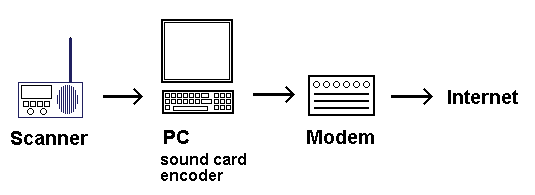
Some of these digital audio streams may require a "helper application" or a "plug-in" that gives your web browser the ability to understand the feed and play it through your computer's speakers. There are several different types of audio conversion software commonly used by these volunteers and the specific type of software will determine the plug-in that you'll need. Most web sites with audio feeds explain which plug-in is needed and how to get the latest version.
There are a number of places on the Internet that maintain lists of different audio feeds. Some of the more popular and comprehensive ones are listed below.
Public Safety Internet Audio Feeds
http://www.policescan.us/
More than 40 entries, including police and fire departments, air traffic control
http://www.freqofnature.com/live_bottom.html
Sorted by state with a graphic icon indicating the type of plug-in required to hear that feed.
http://www.livedispatch.com/live_dispatch.htm
Also has links to scanner feeds in Canada and the Netherlands.
You can also use a search engine like Google to locate other feeds. Use search terms such as "live feed" and "police" to bring up possible sites. Don't be discouraged if you don't locate what you want on the first try. Because these feeds are provided by volunteers, you may find that they come and go and may be "down" (unavailable) at any particular time.
Computer-Aided Dispatch
If you don't want to listen to an audio feed but still want to keep up with what's going on, a many of the larger departments across the country maintain Computer-Aided Dispatch (CAD) web pages with textual descriptions of incidents and activity.
For instance, the California Highway Patrol (CHP) operates a CAD page that lists traffic accidents and related ambulance calls, including rescues and car fires. You can see the current activity at the cad.chp.ca.gov web page. Pinellas County, Florida, has a similar page set up at http://www.co.pinellas.fl.us/ces/ActCallsPub.htm.
South Dakota
Hi Dan,I just read your article on the Internet. I found it very interesting. I will tell you first what I have then my question. I have a new Uniden BC785D Scanner. I have had it since March and have been working on getting it programmed.
I live in Redfield, South Dakota, which is in Spink County. I think I have all frequencies but I get all over the state pretty good; my problem is getting good reception from our local radios in close to me -- they are sort of hard to understand. I am wondering if I am missing a channel or I am too close. The ambulance will use the Miller tower (159.4650 MHz) that is good then the deputies will use 156.2400 or 159.6900, which are not very good. Can you help me with more?
I have 8 frequencies on Crandall tower, 7 on Miller and 5 on Aberdeen. Does Redfield have a tower they are using? Can you provide me with a complete frequency chart and any other help? Oh, I have a Radio Shack antenna, the ham discone antenna that covers 25 to 1300 MHz.
Ally
For frequency and location information, the first place to check is the Federal Communications Commission (FCC). The FCC is responsible for licensing public safety radio systems and they maintain a web site where you can check up on local towers and frequencies.
FCC Frequency Database
Open up your favorite web browser and go to http://wireless.fcc.gov/uls/
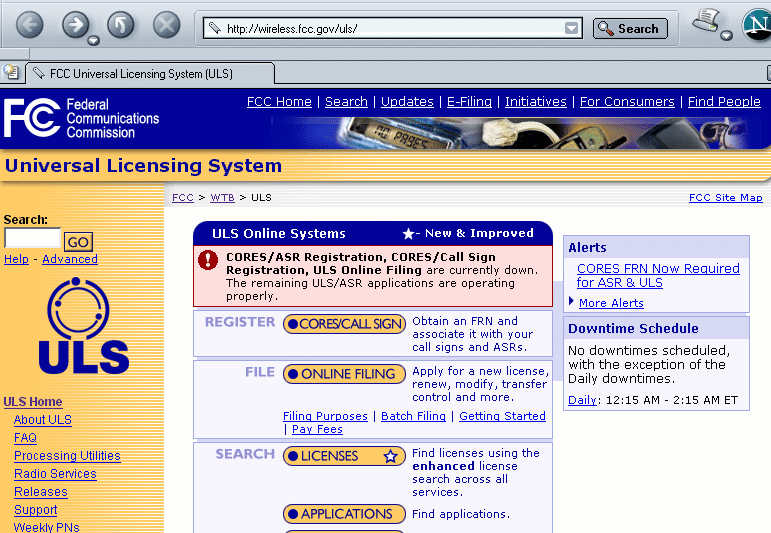
Click on the LICENSES button in the Search section.
Clicking on the Advanced License Search on the left-hand side of the page will bring you to http://wireless2.fcc.gov/UlsApp/UlsSearch/searchAdvanced.jsp, which you can also type directly, but it's longer and more difficult to remember.
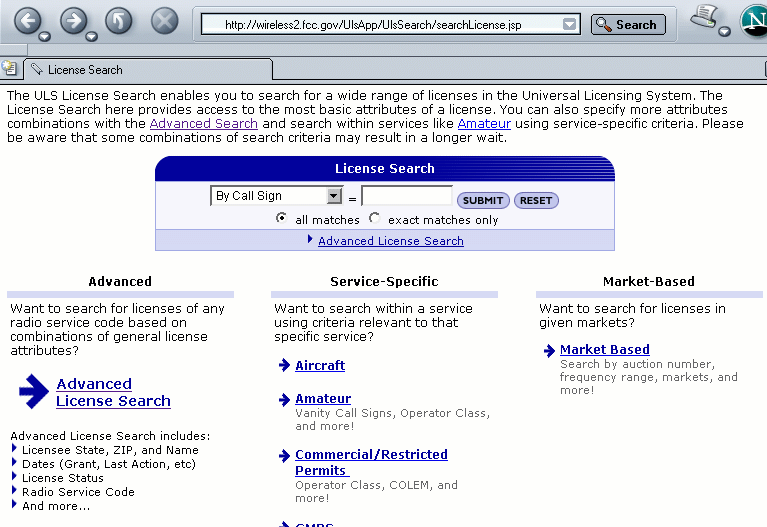
In the Service Group selection list, scroll down and click on
"YW - Public Safety Pool, Trunked" then click on the GEOSEARCH button.
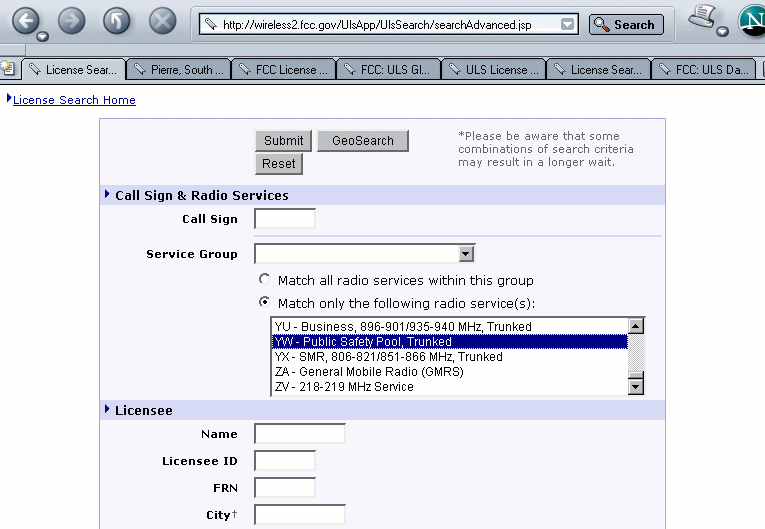
Go to the State/County section and scroll down in the first window until you see "South Dakota" then click on it. A list of counties in South Dakota will then appear in the lower window. Scroll down in that one and click on "SD - Spink." Then click on the SUBMIT button.
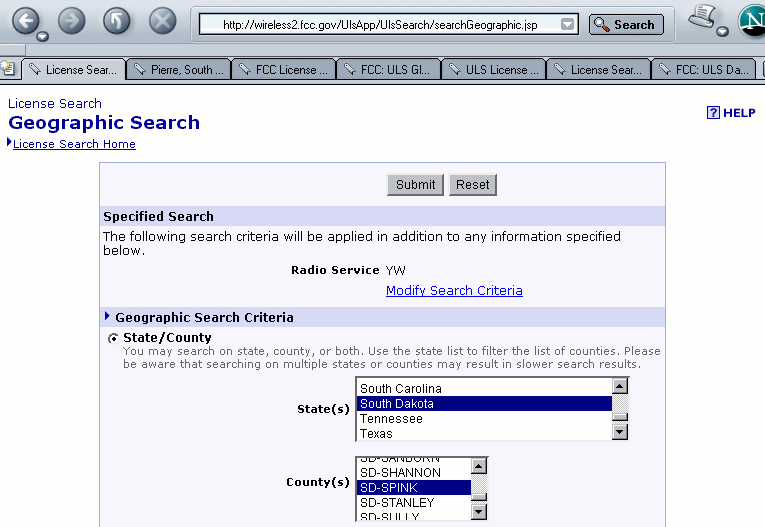
You should get back a list of licenses associated with Spink County.
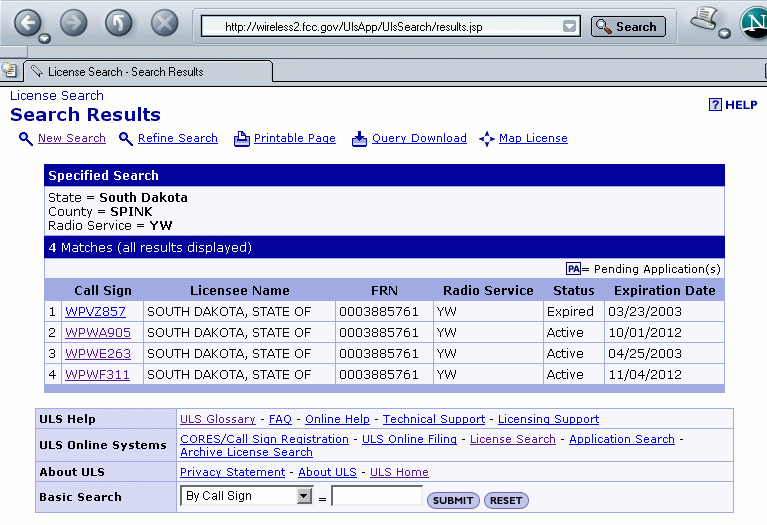
Here are the frequencies that I have for the three counties you mentioned, as taken from the FCC database:
Aberdeen (Brown County): 155.475, 156.015, 156.150, 159.225 and 159.375 MHz
Crandall (Day County): 155.475, 156.015, 156.240, 159.150, 159.690 and 160.140 MHz
Miller (Hand County): 155.475, 156.015, 159.270, 159.465, 159.495, 160.065 and 173.325 MHz
From your letter it appears you're having trouble hearing two frequencies on the Crandall site.
Using the FCC's geographic search feature you can run a search specifically on the town of Redfield. There are several conventional (non-trunked) frequencies transmitting from the top of the Redfield County Courthouse on 7th Avenue, including 154.085 and 154.250 MHz. Other frequencies in the county are also listed in the FCC database (as they should be!), such as 158.76 MHz on U.S. Route 281 and 154.055 MHz from the Redfield State Hospital.
Those local frequencies might give you a chance to check whether attenuation might help your reception problem. If you really are too close to a repeater you should hear an improvement by using the RF attenuation feature on the BC785D. You can read the details in your Owner's Manual on page 31.
EDACS and the PRO-92
I think that I have come across a major shortcoming in the Radio Shack PRO-92:it can only decode and track EDACS AFS codes 00-000 thru 31-157.
When entering EDACS talk group ID's, they have to be entered in 4 digit decimal format, for example 0289.
And the scanner only takes numbers from 0000 to 4095, which corresponds to AFS codes 00-000 thru 31-157.
Does EDACS use AFS number higher than 31-157? I suspect that it does, because some EDACS systems must have many thousands of individual users.
Ever since I bought my PRO-92 a few years ago, I have never been able to pick up the city buses on the EDACS system.
I can pick up the bus supervisors and maintenance on a range of 0289 to 0294 talk group ID's, but whenever the individual buses talk, the scanner will not decode them. If I use another radio in conventional mode, I can hear the individual buses. And during one conversation, I heard the dispatcher describe how each bus's ID shows up on the data terminal in the office.
So, I suspect that the buses are using an ID that is greater than the max 31-157 that the PRO-92 takes.
Via the Internet, I checked the user manual for the PRO 94, and talk group ID is entered in AFS format. The manual does not mention any limit to the numbers, and so I would suspect that something like 60-000 could be entered. So, the problem that I have encountered may be common only to the PRO-92.
It is time to buy a new scanner. I wonder what other agencies and fleets are on the system above 31-157.
I like the PRO-92, though, because it tracks LTR, and the electric company here uses LTR.
William
I happen to like the PRO-92 as well, and the LTR (Logic Trunked Radio) tracking is a nice feature. But you asked about EDACS talkgroups.
Enhanced Digital Access Communications System (EDACS) radios have two main types of message traffic. The first is the group call, which is the case when a user wishes to communicate with other users in a group. Group call messages use talkgroup identifiers to indicate which group should participate in the conversation.
EDACS talkgroup identifiers are usually represented as either a 4-digit decimal number or in Agency-Fleet-Subfleet (AFS) format.
AFS identifiers are composed of 11 binary digits (bits). The first four bits are assigned as the agency number. The next four bits are the fleet number. The final three bits are the subfleet number.
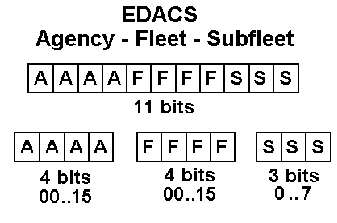
Rather than display eleven 1's and 0's, AFS identifiers are shown as two decimal numbers separated by a dash. The number before the dash is the agency number and can range from 00 to 15 (the first four of 11 bits). The number to the right of the dash has two parts. The first two digits represent the fleet number, which again can range from 00 to 15 (the second four of 11 bits). The final digit is the subfleet number and can go from 0 to 7 (the last three of 11 bits).
So, AFS identifiers go from 00-000 to 15-157.
The second type of common EDACS message traffic is the individual call, which allows two users to talk privately with each other. In this case talkgroup identifiers are not used -- individual radio identifiers are used instead.
The PRO-92 tracks talkgroups. It does not track individual calls, although as you've discovered you can hear the voice traffic of individual calls if you listen in conventional mode.
What appears to be happening is that dispatch calls are sent out to the buses as group calls, so they use a talkgroup and the PRO-92 can track them. When the bus responds, it uses an individual call and the PRO-92 in trunking mode ignores those types of calls.
Seasonal Checklist
For those of you living in climates with seasonal change, autumn is just around the corner. Now is the time to check your outdoor equipment and make sure everything is ready for winter. Much better to make repairs and recheck connections now, while the weather is nice, than when it's cold and blustery outside.
That's all for this month. As always, more information is available on my website at www.signalharbor.com, including updated APCO-25 system frequencies and tower locations. I also welcome your electronic mail at dan @ monitoringtimes.com. Until next month, happy monitoring!